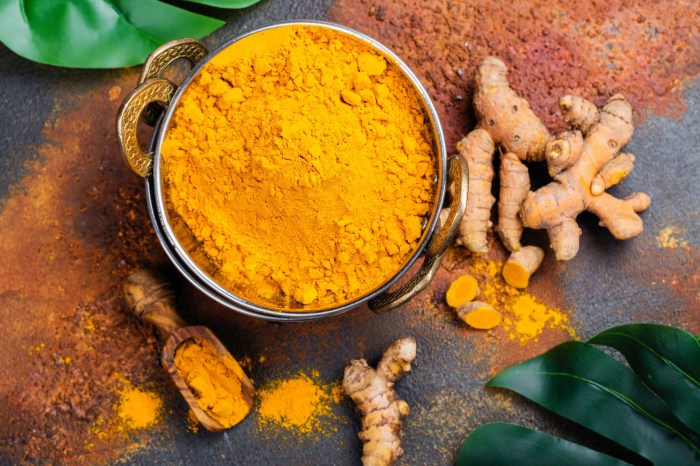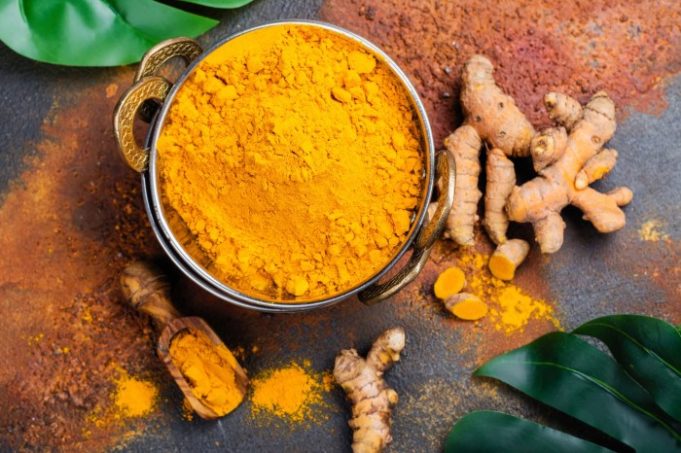How to add turmeric to diet – How to add turmeric to your diet is a question many are asking, and for good reason! This vibrant spice, known for its golden hue and earthy flavor, has been a staple in traditional medicine for centuries. Turmeric’s active compound, curcumin, is a powerful antioxidant and anti-inflammatory agent that has been linked to numerous health benefits, from boosting immunity to promoting brain health.
Whether you’re looking to incorporate turmeric into your daily meals or explore the benefits of supplements, there are various ways to enjoy this versatile spice. From adding it to curries and smoothies to creating golden milk, the possibilities are endless. This guide will explore the different ways to add turmeric to your diet, discuss its potential benefits, and offer tips for maximizing its absorption.
Turmeric
Turmeric, a vibrant yellow spice derived from the rhizome (underground stem) of the Curcuma longa plant, has been a staple in traditional medicine and culinary practices for centuries. Its rich, earthy flavor and vibrant hue have captivated taste buds and sparked curiosity about its potential health benefits.
Turmeric’s Health Benefits
Turmeric has garnered considerable attention for its potential health benefits, primarily attributed to its potent anti-inflammatory and antioxidant properties.
- Anti-inflammatory Properties: Turmeric’s anti-inflammatory properties stem from curcumin, its active compound. Curcumin has been shown to inhibit the production of inflammatory molecules, such as cytokines and prostaglandins, which contribute to chronic inflammation associated with various diseases. Studies have indicated that curcumin may help manage conditions like arthritis, inflammatory bowel disease, and cardiovascular disease.
- Antioxidant Properties: Turmeric’s antioxidant properties are also linked to curcumin. Curcumin acts as a free radical scavenger, protecting cells from damage caused by oxidative stress. Oxidative stress is implicated in aging and various diseases, including cancer and neurodegenerative disorders. Turmeric’s antioxidant potential may contribute to its protective effects against these conditions.
Curcumin: The Active Compound in Turmeric
Curcumin is the primary bioactive compound responsible for turmeric’s medicinal properties. Its potent anti-inflammatory and antioxidant effects have made it a subject of extensive research. Studies have suggested that curcumin may offer benefits for:
- Cognitive Health: Curcumin has shown potential in improving cognitive function and reducing the risk of neurodegenerative disorders like Alzheimer’s disease. Research suggests that curcumin may protect brain cells from damage and enhance memory and learning abilities.
- Cardiovascular Health: Curcumin may contribute to cardiovascular health by lowering cholesterol levels, improving blood vessel function, and reducing blood pressure. Studies have shown that curcumin may help prevent blood clots and reduce the risk of heart disease.
- Cancer Prevention: Some research suggests that curcumin may have anticancer properties. Studies have indicated that curcumin may inhibit the growth and spread of cancer cells, particularly in cancers like colon, breast, and prostate cancer. However, more research is needed to confirm these effects.
Traditional Uses of Turmeric
Turmeric has a rich history of use in traditional medicine and culinary practices around the world.
- Ayurveda: In Ayurveda, a traditional Indian system of medicine, turmeric has been used for centuries to treat a wide range of ailments, including inflammation, infections, and digestive problems. It is believed to possess healing properties that promote overall well-being.
- Chinese Medicine: In Traditional Chinese Medicine, turmeric is used to alleviate pain, reduce inflammation, and promote blood circulation. It is often included in herbal formulas to address various health concerns.
- Culinary Use: Turmeric is a staple spice in many cuisines, particularly in South Asian, Southeast Asian, and Middle Eastern dishes. It imparts a vibrant yellow color and a warm, earthy flavor to curries, stews, and marinades. Its culinary use extends beyond its flavor, as it is also believed to offer health benefits when consumed regularly.
Incorporating Turmeric into Your Diet
Turmeric is a versatile spice that can be easily incorporated into your daily meals. It’s a great way to add flavor and color to your food, and it also provides a variety of health benefits.
Different Ways to Add Turmeric to Meals
Turmeric can be added to various dishes, enhancing their flavor and nutritional value.
- Curries: Turmeric is a key ingredient in many curries, giving them their vibrant yellow color and earthy flavor. You can use it in both traditional Indian curries and modern variations.
- Soups: Add turmeric to soups for a warm, comforting flavor. It complements both creamy and broth-based soups, and can be used in various soup recipes.
- Smoothies: Turmeric can be added to smoothies for a boost of antioxidants and anti-inflammatory properties. Blend it with fruits, vegetables, and other ingredients for a delicious and healthy drink.
- Marinades: Turmeric can be used in marinades for meat, poultry, and fish. It adds a unique flavor and helps tenderize the meat.
- Eggs: Add turmeric to scrambled eggs or omelets for a subtle flavor and vibrant yellow hue.
- Rice: Add turmeric to rice while cooking for a flavorful and colorful side dish.
- Roasted Vegetables: Toss vegetables with turmeric before roasting for a delicious and healthy side dish.
Turmeric-Infused Recipes
Here are some recipes that incorporate turmeric:
| Recipe Name | Ingredients | Preparation Steps | Health Benefits |
|---|---|---|---|
| Golden Milk |
|
|
|
| Turmeric Chicken Curry |
|
|
|
| Turmeric Smoothie |
|
|
|
Weekly Meal Plan Incorporating Turmeric
Here is a sample weekly meal plan incorporating turmeric into breakfast, lunch, and dinner:
Monday
- Breakfast: Golden Milk with a side of fruit
- Lunch: Turmeric Chicken Salad Sandwich on whole-wheat bread
- Dinner: Turmeric-Roasted Salmon with roasted vegetables
Tuesday
- Breakfast: Turmeric Oatmeal with berries and nuts
- Lunch: Leftover Turmeric Chicken Salad Sandwich
- Dinner: Lentil Soup with turmeric and ginger
Wednesday
- Breakfast: Turmeric Smoothie
- Lunch: Turmeric-Infused Quinoa Salad with grilled chicken or tofu
- Dinner: Vegetable Curry with turmeric, coconut milk, and chickpeas
Thursday
- Breakfast: Scrambled eggs with turmeric and spinach
- Lunch: Leftover Vegetable Curry
- Dinner: Chicken Stir-fry with turmeric, ginger, and garlic
Friday
- Breakfast: Turmeric Pancakes with fruit and yogurt
- Lunch: Turmeric-Roasted Sweet Potato and Black Bean Salad
- Dinner: Turmeric-Marinated Grilled Chicken with brown rice and steamed vegetables
Saturday
- Breakfast: Turmeric French Toast with berries
- Lunch: Leftover Turmeric-Marinated Grilled Chicken
- Dinner: Turmeric-Infused Vegetable Pizza
Sunday
- Breakfast: Golden Milk with a side of fruit
- Lunch: Leftover Turmeric-Infused Vegetable Pizza
- Dinner: Turmeric-Glazed Salmon with roasted asparagus and quinoa
Turmeric Supplements

Turmeric supplements are a popular way to increase your intake of curcumin, the active compound in turmeric. They come in various forms, each with its benefits and drawbacks.
Types of Turmeric Supplements
Turmeric supplements are available in several forms, including capsules, powders, and extracts.
- Capsules: Turmeric capsules are convenient and easy to swallow. They typically contain a standardized amount of curcuminoids, making it easier to track your intake.
- Powders: Turmeric powder is a versatile supplement that can be added to smoothies, yogurt, or sprinkled on food. It is generally less expensive than capsules but may be less potent.
- Extracts: Turmeric extracts are concentrated forms of turmeric that contain a higher percentage of curcuminoids. They are typically more expensive than capsules or powders but may be more effective.
Benefits and Drawbacks of Different Turmeric Supplement Forms
The choice of turmeric supplement form depends on individual preferences and needs.
| Form | Benefits | Drawbacks |
|---|---|---|
| Capsules | Convenient, easy to swallow, standardized curcuminoid content | May be more expensive than powders, less versatile than powders |
| Powders | Versatile, can be added to food and drinks, less expensive than capsules | May be less potent than capsules or extracts, difficult to track intake |
| Extracts | Higher concentration of curcuminoids, may be more effective | More expensive than capsules or powders, may have a stronger taste or odor |
Recommended Dosage and Potential Side Effects
The recommended dosage of turmeric supplements varies depending on the form and the intended use.
Generally, 400-600 mg of curcuminoids per day is considered safe for most adults.
Turmeric supplements are generally safe for most people. However, some potential side effects include:
- Gastrointestinal upset: Turmeric can cause stomach upset, diarrhea, or nausea in some people.
- Blood thinning: Turmeric may increase the risk of bleeding, especially in people taking blood thinners.
- Allergic reactions: Some people may be allergic to turmeric.
It is important to talk to your doctor before taking turmeric supplements, especially if you have any underlying health conditions or are taking any medications.
Tips for Maximizing Turmeric Absorption
While turmeric itself offers numerous health benefits, maximizing its absorption can significantly enhance its effects. This involves understanding the factors that influence curcumin absorption and implementing strategies to optimize its bioavailability.
Combining Turmeric with Black Pepper, How to add turmeric to diet
Black pepper contains a compound called piperine, which has been shown to significantly increase curcumin absorption. Piperine acts as a bioavailability enhancer, preventing the breakdown of curcumin in the liver and promoting its absorption into the bloodstream.
Foods that Enhance Turmeric Absorption
Certain foods can contribute to better curcumin absorption. These foods are rich in healthy fats and fatty acids, which aid in the absorption of curcumin.
- Healthy Fats: Incorporating healthy fats like olive oil, avocado oil, coconut oil, and nuts into your diet can improve curcumin absorption. These fats help solubilize curcumin, making it easier for the body to absorb.
- Fatty Acids: Foods rich in omega-3 fatty acids, such as salmon, tuna, and flaxseeds, have also been shown to enhance curcumin absorption. Omega-3 fatty acids may help improve the overall health of the digestive system, promoting better nutrient absorption.
Preparing Turmeric for Optimal Absorption
There are several ways to prepare turmeric to maximize its absorption.
- Warm Water: Adding turmeric to warm water, especially with a pinch of black pepper, can improve its absorption. The warmth helps dissolve curcumin, while the piperine in black pepper further enhances its bioavailability.
- Turmeric Latte: Creating a turmeric latte by adding turmeric to milk or plant-based milk, along with a touch of black pepper and other spices, can be a delicious and effective way to increase curcumin absorption.
- Cooking with Turmeric: Using turmeric in cooking, especially when combined with healthy fats like olive oil or coconut oil, can enhance its absorption. The heat from cooking can help release curcuminoids from the turmeric root.
Turmeric and Other Health Conditions
Turmeric has been used in traditional medicine for centuries, and modern research is starting to uncover its potential benefits for a variety of health conditions. While more research is needed to fully understand its effects, turmeric shows promise in addressing issues like arthritis, digestive problems, and even certain types of cancer.
Turmeric and Arthritis
Turmeric’s anti-inflammatory properties have led to its exploration as a potential treatment for arthritis. The active compound in turmeric, curcumin, has been shown to reduce inflammation and pain associated with osteoarthritis and rheumatoid arthritis.
- A study published in the journal *Phytotherapy Research* found that curcumin was as effective as ibuprofen in reducing pain and improving function in patients with osteoarthritis of the knee.
- Another study, published in the journal *Alternative Therapies in Health and Medicine*, found that curcumin supplementation significantly reduced pain, stiffness, and swelling in patients with rheumatoid arthritis.
Turmeric and Digestive Issues
Turmeric has long been used in traditional medicine to treat digestive issues, and research suggests it may be beneficial for conditions like irritable bowel syndrome (IBS) and inflammatory bowel disease (IBD).
- Curcumin has been shown to reduce inflammation in the gut, which may help alleviate symptoms of IBS and IBD.
- Studies have also shown that curcumin can protect the stomach lining from damage caused by ulcers and other digestive problems.
Turmeric and Cancer
Research suggests that turmeric may have anti-cancer properties. Curcumin has been shown to inhibit the growth and spread of cancer cells in laboratory and animal studies.
- Studies have shown that curcumin can reduce the risk of developing certain types of cancer, including colon, breast, and prostate cancer.
- Curcumin may also help to prevent cancer cells from spreading to other parts of the body.
Turmeric and Medications
It’s important to note that turmeric can interact with certain medications. For example, turmeric may increase the risk of bleeding when taken with blood thinners.
- It’s essential to talk to your doctor before taking turmeric if you are taking any medications, especially blood thinners, diabetes medications, or chemotherapy drugs.
Culinary Applications of Turmeric
Turmeric’s vibrant yellow hue and earthy, slightly peppery flavor make it a versatile spice that can elevate a wide range of dishes. From savory curries to sweet desserts, turmeric can add a unique depth of flavor and a touch of vibrant color to your culinary creations.
Recipes Featuring Turmeric
Here are a few popular recipes that showcase the versatility of turmeric in the kitchen:
- Golden Milk: This warming and comforting beverage is a staple in Ayurvedic medicine. It is made by simmering turmeric, ginger, cinnamon, and black pepper in milk or plant-based milk. Golden milk is believed to have anti-inflammatory and antioxidant properties.
- Turmeric Rice: A simple yet flavorful dish, turmeric rice is made by cooking rice with turmeric, salt, and sometimes other spices like cumin or coriander. The turmeric imparts a beautiful yellow color and a subtle earthy flavor to the rice.
- Turmeric-Infused Hummus: A vibrant and flavorful twist on classic hummus, turmeric-infused hummus is made by adding turmeric to the traditional hummus ingredients. The turmeric adds a warm, earthy note to the hummus, complementing the chickpeas and tahini.
This turmeric rice recipe is a simple yet flavorful dish that is perfect for a quick and healthy meal. To prepare it, simply cook rice with turmeric, salt, and a little bit of oil. You can also add other spices like cumin or coriander for a more complex flavor profile. The turmeric imparts a beautiful yellow color and a subtle earthy flavor to the rice. Garnish with fresh cilantro and a sprinkle of toasted sesame seeds for an extra touch of flavor and texture.
Adding turmeric to your diet is a simple way to boost your health. You can incorporate it into smoothies, soups, or even your morning tea. If you’re looking to lose belly fat, you might want to consider the best diet to lose belly fat female for personalized guidance.
No matter your approach, turmeric’s anti-inflammatory properties can contribute to overall well-being and potentially aid in your weight loss journey.
Flavors and Textures
Turmeric can contribute a range of flavors and textures to various dishes. Its earthy and slightly peppery flavor pairs well with both savory and sweet ingredients. It can be used to add a warm, comforting note to soups, stews, and curries, or to create a vibrant and flavorful marinade for meats and vegetables. Turmeric also has a slightly bitter note that can be balanced by adding sweet ingredients like honey or maple syrup.
Final Summary: How To Add Turmeric To Diet
Adding turmeric to your diet can be a delicious and healthy way to enhance your well-being. From its vibrant color and unique flavor to its potential health benefits, turmeric is a versatile spice worth exploring. Whether you’re incorporating it into your daily meals or experimenting with supplements, remember to consult with a healthcare professional for personalized guidance. By embracing the power of turmeric, you can embark on a journey toward a healthier and more vibrant life.
FAQ Insights
Is it safe to consume turmeric every day?
In general, consuming turmeric in moderation is safe for most people. However, it’s always best to consult with your doctor, especially if you have any underlying health conditions or are taking medications.
How much turmeric should I consume daily?
There’s no one-size-fits-all answer, but a good starting point is to aim for 1-2 teaspoons of turmeric powder per day.
What are the potential side effects of turmeric?
Turmeric is generally well-tolerated, but some people may experience mild side effects like stomach upset or diarrhea. If you experience any adverse reactions, stop using turmeric and consult with your doctor.
Can turmeric interact with any medications?
Yes, turmeric can interact with certain medications, especially blood thinners and medications for diabetes. It’s important to talk to your doctor before adding turmeric to your diet if you’re taking any medications.
Incorporating turmeric into your diet can be as simple as adding it to smoothies, soups, or even your morning oatmeal. While turmeric is known for its anti-inflammatory properties, it can also be a helpful addition to a best diet to gain weight , as it can help improve digestion and nutrient absorption.
If you’re looking to gain weight, focus on a balanced diet rich in healthy fats, proteins, and complex carbohydrates, and turmeric can be a flavorful and beneficial addition to your meals.
Adding turmeric to your diet is easy! You can sprinkle it on your food, stir it into smoothies, or even add it to your morning tea. To boost your overall health, make sure you’re also getting enough fibre, which is crucial for digestion and overall well-being.
You can learn more about how to get more fibre in your diet here. Turmeric is a great way to add a touch of flavour and colour to your meals while also providing anti-inflammatory benefits.

























